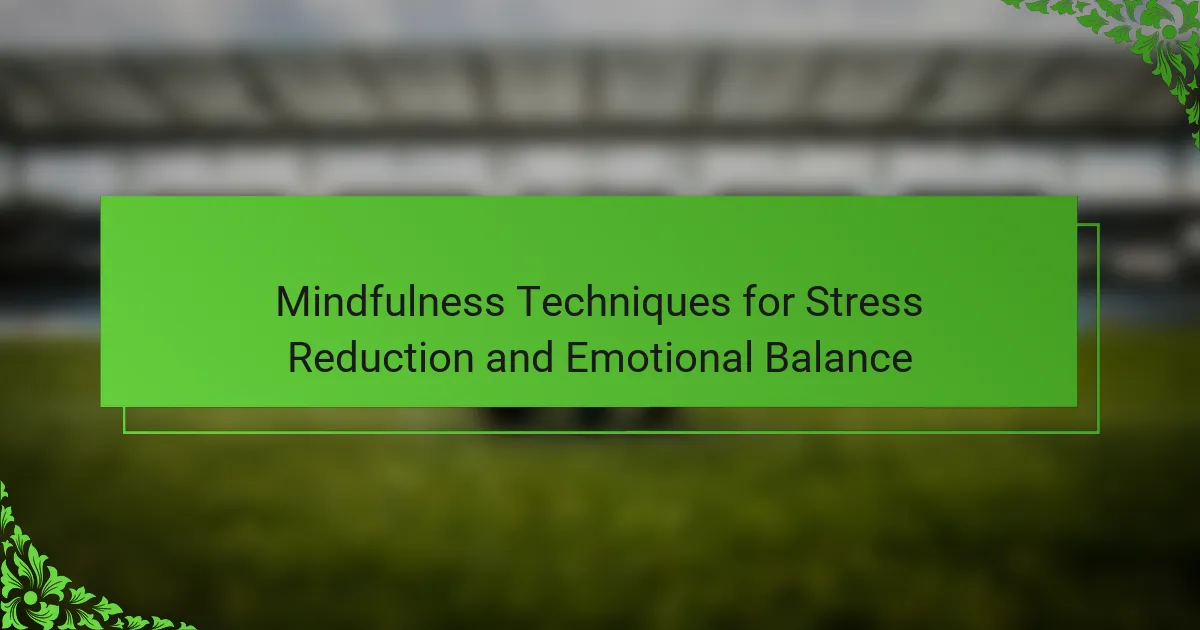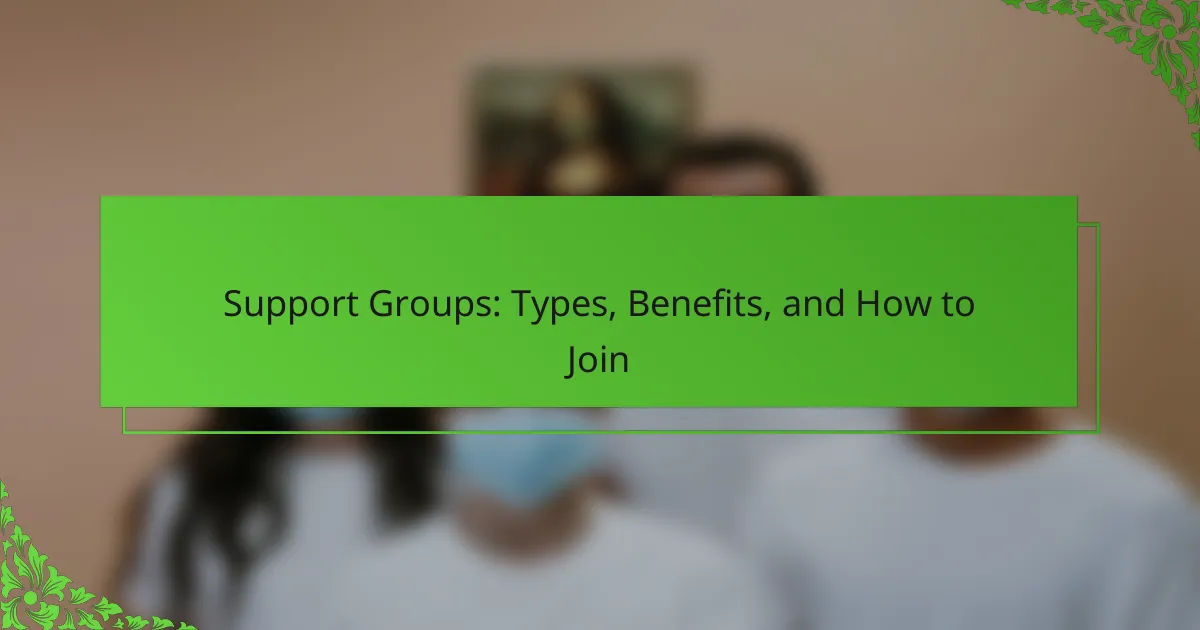Mindfulness techniques are effective for reducing stress and achieving emotional balance. Key practices include deep breathing, body scan meditation, mindful walking, and loving-kindness meditation. These methods enhance awareness, promote relaxation, and foster compassion. Incorporating mindfulness into daily routines can lead to significant improvements in mental health and emotional resilience.

What are the key mindfulness techniques for stress reduction?
Mindfulness techniques for stress reduction include practices that enhance emotional balance. Key techniques are deep breathing, body scan meditation, mindful walking, and loving-kindness meditation.
Deep breathing focuses on slow, intentional breaths to reduce anxiety and promote relaxation. Body scan meditation encourages awareness of physical sensations, helping to release tension. Mindful walking connects movement with present awareness, fostering calmness. Loving-kindness meditation cultivates compassion towards oneself and others, improving emotional well-being.
Incorporating these techniques into daily routines can significantly lower stress levels and enhance overall mental health.
How does mindful breathing help in managing stress?
Mindful breathing effectively reduces stress by promoting relaxation and enhancing emotional balance. This technique encourages awareness of the breath, which calms the nervous system and decreases anxiety. Research indicates that even a few minutes of focused breathing can lower cortisol levels, the stress hormone. Practicing mindful breathing regularly fosters resilience against stress and improves overall mental well-being.
What role does body scan meditation play in emotional balance?
Body scan meditation significantly enhances emotional balance by promoting mindfulness and self-awareness. This technique encourages individuals to focus on physical sensations, fostering a deeper connection to their emotions. As a result, practitioners often report reduced anxiety and improved emotional regulation. Research indicates that regular practice can lead to a decrease in stress levels, contributing to overall mental well-being. Additionally, body scan meditation helps identify emotional triggers, allowing for proactive management of stress responses.
Which mindfulness practices are most effective for anxiety relief?
Mindfulness practices such as meditation, deep breathing, and body scanning are highly effective for anxiety relief. These techniques promote relaxation, enhance emotional balance, and reduce stress levels.
Meditation encourages focus and presence, helping to quiet racing thoughts. Deep breathing exercises stimulate the parasympathetic nervous system, lowering heart rate and inducing calmness. Body scanning increases awareness of physical sensations, promoting acceptance and reducing tension.
Research shows that regular mindfulness practice can lead to significant reductions in anxiety symptoms. For instance, a study found that participants practicing mindfulness meditation experienced a 30% decrease in anxiety levels after eight weeks.
Incorporating these practices into daily routines can foster resilience against anxiety and improve overall mental well-being.
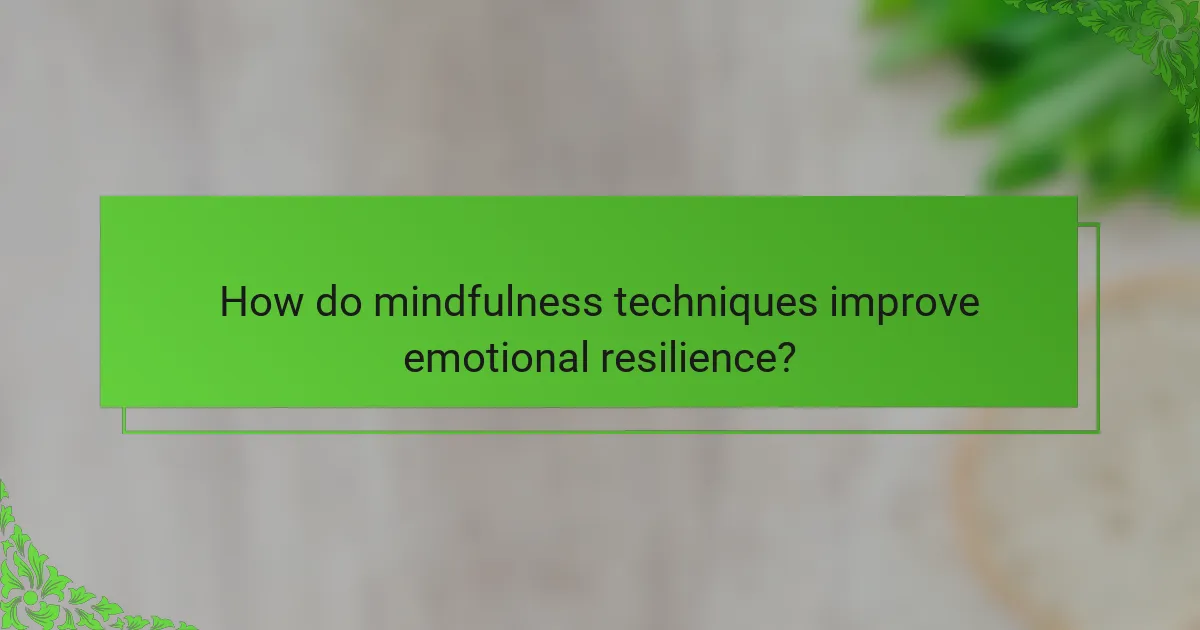
How do mindfulness techniques improve emotional resilience?
Mindfulness techniques enhance emotional resilience by promoting awareness and acceptance of thoughts and feelings. These practices reduce stress and improve emotional balance. Techniques such as meditation, deep breathing, and body scanning cultivate a non-judgmental attitude, allowing individuals to respond to stressors more effectively. Research shows that regular mindfulness practice can decrease anxiety and increase overall well-being, leading to stronger emotional resilience. Additionally, mindfulness fosters greater self-awareness, enabling individuals to identify triggers and manage emotional responses proactively.
What are the psychological benefits of daily mindfulness practice?
Daily mindfulness practice offers significant psychological benefits, including reduced stress and improved emotional balance. It enhances self-awareness, allowing individuals to better understand their thoughts and feelings. Research indicates that mindfulness can decrease anxiety levels by promoting relaxation and fostering a sense of calm. Additionally, it helps regulate emotions, leading to greater resilience in facing life’s challenges. Regular practice can also improve focus and cognitive flexibility, which contributes to better decision-making. Overall, these benefits create a more balanced and fulfilling life.
How can mindfulness enhance self-awareness and emotional regulation?
Mindfulness enhances self-awareness and emotional regulation by fostering present-moment awareness. This practice allows individuals to observe their thoughts and feelings without judgment, leading to better emotional responses. Techniques such as mindful breathing and body scans improve emotional balance by reducing stress levels. Research indicates that regular mindfulness practice can decrease anxiety and increase resilience, promoting overall well-being.
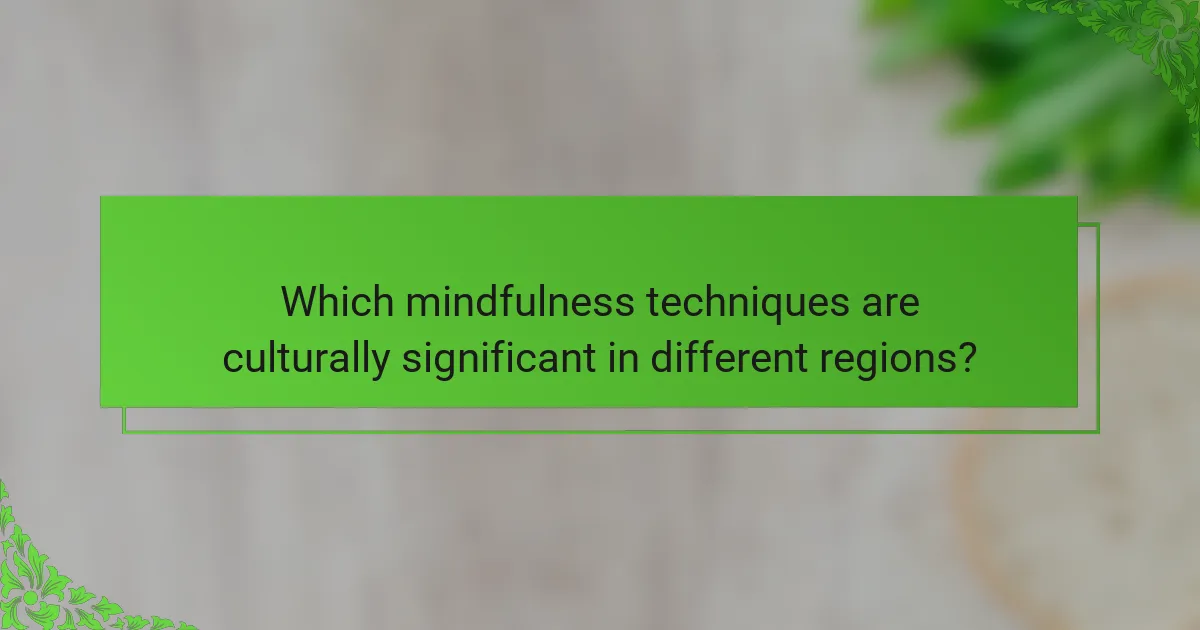
Which mindfulness techniques are culturally significant in different regions?
Mindfulness techniques vary significantly across cultures, each offering unique approaches to stress reduction and emotional balance. In Asia, practices like Zen meditation emphasize presence and awareness. In India, yoga combines physical postures with breath control to enhance mental clarity. In the West, mindfulness-based stress reduction (MBSR) integrates meditation with cognitive therapy, focusing on present-moment awareness. Indigenous cultures often use nature-based rituals to foster connection and grounding. Each technique reflects its cultural roots, providing distinct pathways to emotional wellness.
How is mindfulness practiced in Eastern cultures compared to Western approaches?
Mindfulness is practiced differently in Eastern cultures compared to Western approaches, focusing on holistic integration versus structured techniques. Eastern practices often emphasize meditation, breath awareness, and connection to nature, fostering deep emotional balance. In contrast, Western approaches generally incorporate mindfulness into therapeutic frameworks, emphasizing cognitive behavioral techniques and stress reduction methods.
Eastern mindfulness techniques typically include Zen meditation, yoga, and tai chi, promoting a sense of unity with the environment. These practices encourage individuals to cultivate awareness of thoughts and feelings without judgment. Western methods, however, often focus on mindfulness-based stress reduction (MBSR) and mindfulness-based cognitive therapy (MBCT), aimed at enhancing mental health through structured exercises.
Cultural context plays a significant role in shaping these practices. Eastern traditions view mindfulness as a way of life, deeply rooted in spirituality and community. Western approaches often treat mindfulness as a tool for personal development and psychological well-being. This distinction influences how individuals engage with mindfulness, impacting their overall emotional balance and stress management.
What unique mindfulness rituals are found in specific communities?
Unique mindfulness rituals in specific communities include practices such as forest bathing in Japan, which emphasizes immersion in nature for mental clarity. In Bhutan, the practice of “Gross National Happiness” integrates mindfulness into everyday governance and community life. The Hopi tribe in the United States engages in ceremonial dances that promote collective mindfulness and emotional balance. Additionally, the practice of “Singing Circles” in various Indigenous cultures fosters connection and emotional release through music. Each of these rituals showcases the unique ways communities utilize mindfulness for stress reduction and emotional well-being.
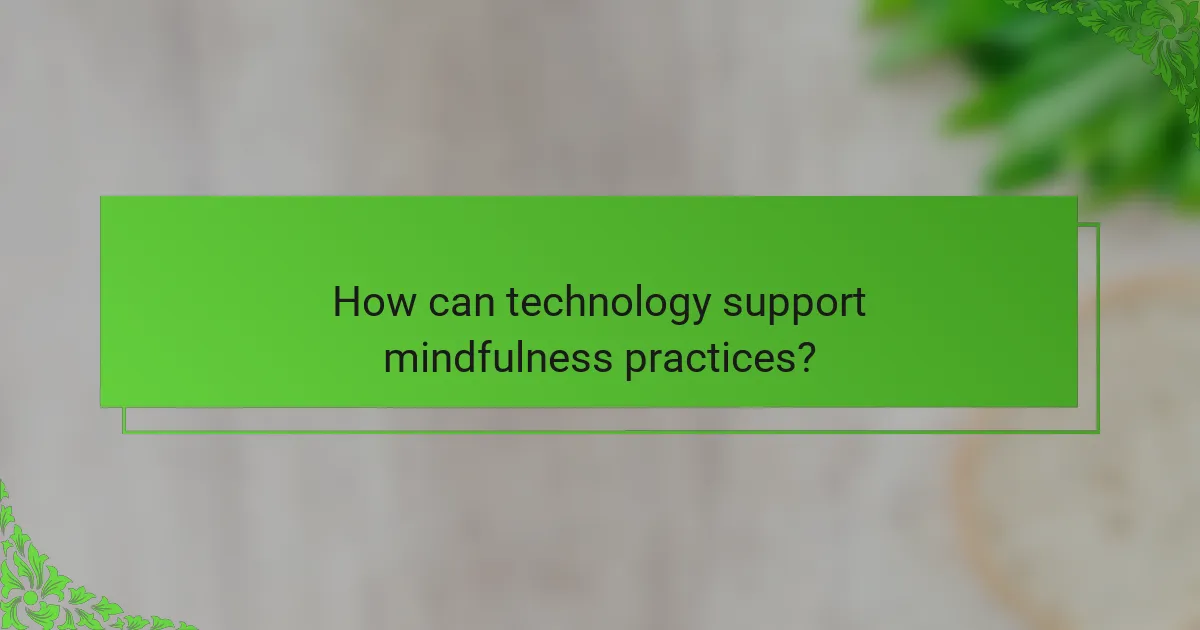
How can technology support mindfulness practices?
Technology enhances mindfulness practices by providing tools that promote focus and emotional well-being. Apps like Headspace and Calm offer guided meditations, while wearable devices track stress levels and encourage mindfulness breaks. Virtual reality experiences immerse users in calming environments, facilitating deeper relaxation. Online communities foster support and accountability, helping individuals maintain their mindfulness journey. These technological advancements make mindfulness more accessible and tailored to personal needs.
Which apps are best for guided mindfulness meditation?
The best apps for guided mindfulness meditation include Headspace, Calm, Insight Timer, and 10% Happier. These apps offer diverse techniques for stress reduction and emotional balance.
Headspace provides structured courses and themed meditations. Calm features soothing soundscapes and sleep stories. Insight Timer has a vast library of free meditations from various teachers. 10% Happier focuses on practical mindfulness techniques for skeptics.
These apps cater to different preferences, making it easier to find a suitable option for individual needs.
How do online courses enhance mindfulness learning?
Online courses enhance mindfulness learning by providing accessible, structured, and flexible environments. They offer diverse mindfulness techniques, such as guided meditations and breathing exercises, which help reduce stress and promote emotional balance.
The interactive nature of online courses fosters community support, allowing learners to share experiences and insights. This engagement reinforces mindfulness practices and encourages consistency in application.
Additionally, many online platforms utilize multimedia resources, such as videos and podcasts, to cater to different learning styles. This variety enhances retention and deepens understanding of mindfulness concepts.
Finally, the convenience of online courses enables individuals to integrate mindfulness into their daily routines, making it easier to practice regularly and achieve lasting emotional balance.

What challenges do individuals face when adopting mindfulness techniques?
Individuals face several challenges when adopting mindfulness techniques, including difficulty maintaining focus, managing expectations, and overcoming emotional discomfort. Many struggle with distractions that hinder their practice, making it hard to achieve a state of mindfulness. Additionally, unrealistic expectations about immediate results can lead to frustration and discouragement. Emotional discomfort may arise during mindfulness exercises, as individuals confront feelings they may have avoided. These challenges can impede the effectiveness of mindfulness practices for stress reduction and emotional balance.
How can beginners overcome common obstacles in mindfulness practice?
Beginners can overcome common obstacles in mindfulness practice by establishing a consistent routine, setting realistic expectations, and embracing self-compassion. Developing a daily schedule helps integrate mindfulness into life. Setting achievable goals reduces frustration. Practicing self-compassion fosters patience and acceptance of the learning process.
What are the misconceptions about mindfulness and stress reduction?
Many misconceptions exist about mindfulness and its role in stress reduction. One common belief is that mindfulness requires complete mental stillness, which is inaccurate; it focuses on awareness of thoughts and feelings without judgment. Another misconception is that mindfulness is a quick fix for stress, while it actually requires consistent practice to yield lasting benefits. Some individuals think mindfulness is solely about meditation, but it encompasses various techniques, including mindful breathing and body scans. Lastly, many believe mindfulness is only beneficial for those with severe stress, yet it can enhance emotional balance for anyone, regardless of their stress levels.
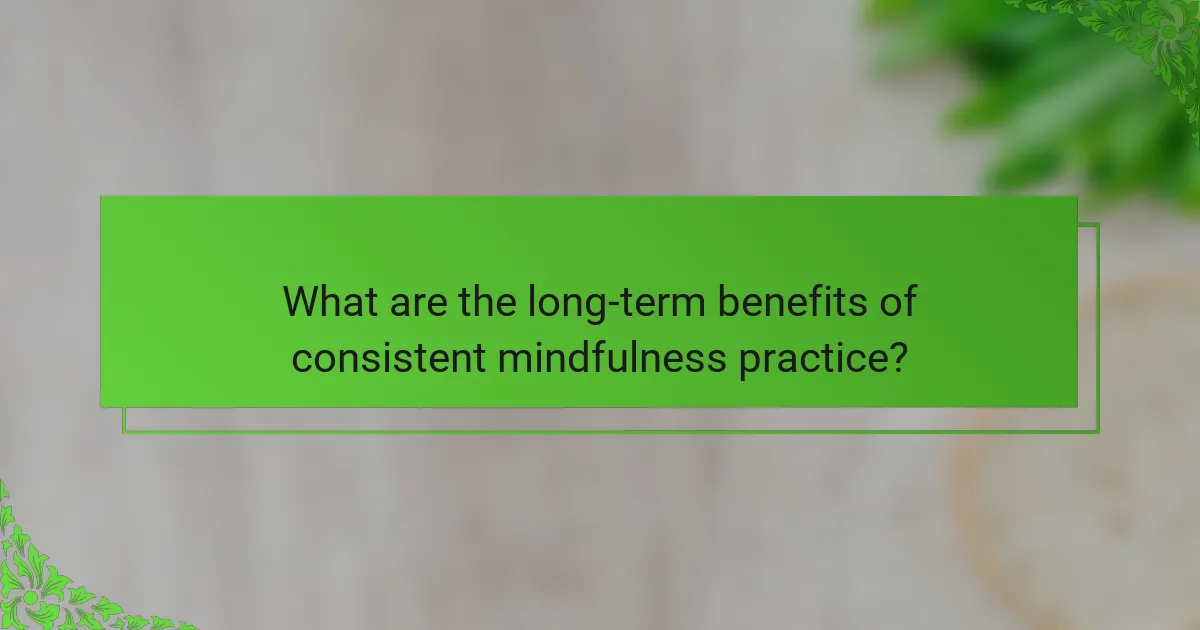
What are the long-term benefits of consistent mindfulness practice?
Consistent mindfulness practice offers long-term benefits such as reduced stress, enhanced emotional balance, and improved overall well-being. Regular engagement with mindfulness techniques fosters resilience against anxiety and depression. Studies show that individuals practicing mindfulness report a 30% decrease in stress levels over time. Additionally, it cultivates greater self-awareness and emotional regulation, allowing for better responses to challenging situations. As a result, practitioners often experience improved relationships and a more positive outlook on life.
How does mindfulness contribute to overall well-being and life satisfaction?
Mindfulness significantly enhances overall well-being and life satisfaction by promoting emotional balance and reducing stress. Practicing mindfulness techniques, such as meditation and deep breathing, helps individuals manage anxiety and improve mood. Research indicates that mindfulness can lower cortisol levels, leading to decreased stress. Furthermore, it encourages present-moment awareness, fostering a positive outlook on life. Individuals who regularly engage in mindfulness practices report higher levels of happiness and satisfaction in daily activities.
What research supports the effectiveness of mindfulness for mental health?
Research supports the effectiveness of mindfulness for mental health through numerous studies demonstrating its impact on stress reduction and emotional balance. Mindfulness practices, such as meditation and breathing exercises, have been shown to decrease anxiety and depression symptoms. For instance, a meta-analysis revealed that mindfulness-based interventions significantly reduced stress levels across various populations. Additionally, research indicates that consistent mindfulness practice enhances emotional regulation, leading to improved mental resilience. These findings underscore mindfulness as a valuable tool for promoting mental well-being.
What best practices should be followed for effective mindfulness?
To practice effective mindfulness, focus on consistency, self-awareness, and non-judgment. Establish a daily routine that includes meditation, breathing exercises, or mindful walking. Aim for at least 10-20 minutes daily to build resilience against stress and promote emotional balance.
1. Create a designated quiet space for mindfulness practice.
2. Use guided meditations or apps for structure.
3. Incorporate mindfulness into daily activities, such as eating or walking.
4. Reflect on thoughts and feelings without judgment.
5. Be patient; progress takes time and practice.
